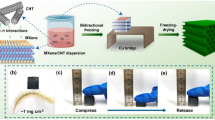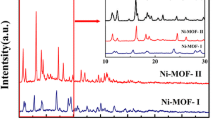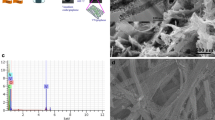Abstract
Graphene sheet/multiwall carbon nanotube (GMC) and its composites with NiO and Ni(OH)2 are synthesized by microwave-assisted technique for the application of high-performance supercapacitor devices. In the present study, carbon nanotubes are used to improve the electrical conductivity and also to prevent the graphene layers from restacking. Moreover, these carbonaceous materials not only are contributing the electrical conductivity but also increase their active sites on composite surfaces. The as-prepared nanocomposites are characterized by powder X-ray diffraction, Raman spectroscopy, FTIR, and BET analyses. The morphological features are visualized by FESEM and HRTEM images that have apparently showed the decoration of GMC composite by Ni(OH)2 nanoparticles. XPS spectra reveal the chemical bond formation and oxidation states of Ni 2p, C 1s, and O 1s energy levels. The maximum specific capacitance of 1663 F g−1 for the corresponding current density of 1 A g−1 is realized in the GMC-Ni(OH)2 nanocomposite-based electrode. In addition, the cyclic stability seems to be good with 95.7% retention even at 2000 charge-discharge cycles. The fabricated asymmetric supercapacitor device delivers a maximum cell voltage of 1.8 V with high energy density (32.85 Wh kg−1) and high power density (3196 W kg−1) at the current density of 4 A g−1. Thus, GMC-Ni(OH)2 nanocomposite is proven to be a promising candidate as active electrode material for high-performance supercapacitor device applications.









Similar content being viewed by others
References
Liu C, Yu Z, Neff D, Zhamu A, Jang BZ (2010) Graphene-based supercapacitor with an ultrahigh energy density. Nano Lett 10(12):4863–4868
Zhang LL, Zhao XS (2009) Carbon-based materials as supercapacitor electrodes. Chem Soc 38(9):2520–2531
Faraji S, Ani FN (2014) Microwave-assisted synthesis of metal oxide/hydroxide composite electrodes for high power supercapacitors—a review. J Power Sources 263:338–360
Conway B, Birss V, Wojtowicz J (1997) The role and utilization of pseudocapacitance for energy storage by supercapacitors. J Power Sources 66(1–2):1–14
Hu C-C, Chang K-H, Lin M-C, Wu Y-T (2006) Design and tailoring of the nanotubular arrayed architecture of hydrous RuO2 for next generation supercapacitors. Nano Lett 6(12):2690–2695
Zhu G, Li H, Deng L, Liu Z-H (2010) Low-temperature synthesis of δ-MnO2 with large surface area and its capacitance. Mater Lett 64(16):1763–1765
Dubal DP, Dhawale DS, Salunkhe RR, Fulari VJ, Lokhande CD (2010) Chemical synthesis and characterization of Mn3O4 thin films for supercapacitor application. J Alloys Compd 497(1):166–170
Liu T-C, Pell W, Conway B (1999) Stages in the development of thick cobalt oxide films exhibiting reversible redox behavior and pseudocapacitance. Electrochim Acta 44(17):2829–2842
Gupta V, Gupta S, Miura N (2008) Al-substituted α-cobalt hydroxide synthesized by potentiostatic deposition method as an electrode material for redox-supercapacitors. J Power Sources 177(2):685–689
Zhang M, Chen K, Chen X, Peng X, Sun X, Xue D (2015) Ethylenediamine-assisted crystallization of Fe2O3 microspindles with controllable size and their pseudocapacitance performance. CrystEngComm 17(7):1521–1525
Shen B, Guo R, Lang J, Liu L, Liu L, Yan X (2016) A high-temperature flexible supercapacitor based on pseudocapacitive behavior of FeOOH in an ionic liquid electrolyte. J Mater Chem A 4(21):8316–8327
Cao C-Y, Guo W, Cui Z-M, Song W-G, Cai W (2011) Microwave-assisted gas/liquid interfacial synthesis of flowerlike NiO hollow nanosphere precursors and their application as supercapacitor electrodes. J Mater Chem 21(9):3204–3209
Xiong X, Ding D, Chen D, Waller G, Bu Y, Wang Z, Liu M (2015) Three-dimensional ultrathin Ni(OH)2 nanosheets grown on nickel foam for high-performance supercapacitors. Nano Energy 11:154–161
Yang Y-Y, Hu Z-A, Zhang Z-Y, Zhang F-H, Zhang Y-J, Liang P-J, Zhang H-Y, Wu H-Y (2012) Reduced graphene oxide–nickel oxide composites with high electrochemical capacitive performance. Mater Chem Phys 133(1):363–368
Vidhyadharan B, Misnon II, Aziz RA, Padmasree K, Yusoff MM, Jose R (2014) Superior supercapacitive performance in electrospun copper oxide nanowire electrodes. J Mater Chem A 2(18):6578–6588
Pramanik A, Maiti S, Mahanty S (2015) Reduced graphene oxide anchored Cu(OH)2 as a high performance electrochemical supercapacitor. Dalton Trans 44(33):14604–14612
Liu Y, Yuan G, Jiang Z, Yao Z, Yue M (2015) Preparation of Ni(OH)2-graphene sheet-carbon nanotube composite as electrode material for supercapacitors. J Alloys Compd 618:37–43
Yuan C, Zhang X, Su L, Gao B, Shen L (2009) Facile synthesis and self-assembly of hierarchical porous NiO nano/micro spherical superstructures for high performance supercapacitors. J Mater Chem 19(32):5772–5777
Bi R-R, Wu X-L, Cao F-F, Jiang L-Y, Guo Y-G, Wan L-J (2010) Highly dispersed RuO2 nanoparticles on carbon nanotubes: facile synthesis and enhanced supercapacitance performance. J Phys Chem C 114(6):2448–2451
Novoselov KS, Geim AK, Morozov SV, Jiang D, Zhang Y, Dubonos SV, Grigorieva IV, Firsov AA (2004) Electric field effect in atomically thin carbon films. Science 306(5696):666–669
Xia J, Chen F, Li J, Tao N (2009) Measurement of the quantum capacitance of graphene. Nat Nanotechnol 4(8):505–509
Rajendran R, Shrestha LK, Kumar RM, Jayavel R, Hill JP, Ariga K (2015) Composite nanoarchitectonics for ternary systems of reduced graphene oxide/carbon nanotubes/nickel oxide with enhanced electrochemical capacitor performance. J Inorg Organomet Polym Mater 25(2):267–274
Tompsett GA, Conner WC, Yngvesson KS (2006) Microwave synthesis of nanoporous materials. ChemPhysChem 7(2):296–319
Conover W (2003) Introduction to green chemistry (Ryan, Mary Ann; Tinnesand, Michael). J Chem Educ 80(3):268
Xu X, Yang W, Liu J, Lin L (2001) Synthesis of NaA zeolite membrane by microwave heating. Sep Purif Technol 25(1):241–249
Hannus I, Kónya Z, Kollár T, Kiyozumi Y, Mizukami F, Lentz P, Nagy J Spectroscopic investigations of the decomposition of CCl2F2 on three different. In: Porous Materials in Environmentally Friendly Processes: Proceedings of the 1st International FEZA Conference, Eger, Hungary, 1–4 September, 1999, 1999. Elsevier, p 245
Tsai T-G, Shih H-C, Liao S-J, K-j C (1998) Well-aligned SAPO-5 membrane: preparation and characterization. Microporous Mesoporous Mater 22(1):333–341
Wang H, Zhang J-R, Zhu J-J (2001) A microwave assisted heating method for the rapid synthesis of sphalrite-type mercury sulfide nanocrystals with different sizes. J Cryst Growth 233(4):829–836
Hummers WS Jr, Offeman RE (1958) Preparation of graphitic oxide. J Am Chem Soc 80(6):1339–1339
Mai L-Q, Minhas-Khan A, Tian X, Hercule KM, Zhao Y-L, Lin X, Xu X (2013) Synergistic interaction between redox-active electrolyte and binder-free functionalized carbon for ultrahigh supercapacitor performance. Nat Commun 4(1):2923
Wang Y, Shi Z, Huang Y, Ma Y, Wang C, Chen M, Chen Y (2009) Supercapacitor devices based on graphene materials. J Phys Chem C 113(30):13103–13107
Jin Z, Lomeda JR, Price BK, Lu W, Zhu Y, Tour JM (2009) Mechanically assisted exfoliation and functionalization of thermally converted graphene sheets. Chem Mater 21(14):3045–3047
Kumar R, Singh RK, Dubey PK, Singh DP, Yadav RM (2015) Self-assembled hierarchical formation of conjugated 3D cobalt oxide nanobead–CNT–graphene nanostructure using microwaves for high-performance supercapacitor electrode. ACS Appl Mater Interfaces 7(27):15042–15051
Understanding Graphene via Raman Scattering. In: Graphene. https://doi.org/10.1002/9783527651122.ch2
Bonhomme F, Lassègues JC, Servant L (2001) Raman spectroelectrochemistry of a carbon supercapacitor. J Electrochem Soc 148(11):E450–E458
Devaraj S, Liu HY, Balaya P (2014) MnCO3: a novel electrode material for supercapacitors. J Mater Chem A 2(12):4276–4281
Zhou M, Chai H, Jia D, Zhou W (2014) The glucose-assisted synthesis of a graphene nanosheet-NiO composite for high-performance supercapacitors. New J Chem 38(6):2320–2326
Luo D, Zhang G, Liu J, Sun X (2011) Evaluation criteria for reduced graphene oxide. J Phys Chem C 115(23):11327–11335
Ferrari AC, Robertson J (2000) Interpretation of Raman spectra of disordered and amorphous carbon. Phys Rev B 61(20):14095–14107
Li H, Yu M, Wang F, Liu P, Liang Y, Xiao J, Wang C, Tong Y, Yang G (2013) Amorphous nickel hydroxide nanospheres with ultrahigh capacitance and energy density as electrochemical pseudocapacitor materials. Nat Commun 4:1894
Lee JW, Ahn T, Soundararajan D, Ko JM, Kim J-D (2011) Non-aqueous approach to the preparation of reduced graphene oxide/α-Ni(OH)2 hybrid composites and their high capacitance behavior. ChemCommun 47(22):6305–6307
Kumar KA, Subalakshmi K, Senthilselvan J (2016) Effect of mixed valence state of titanium on reduced recombination for natural dye-sensitized solar cell applications. J Solid State Electrochem 20(7):1921–1932
Xu Y, Huang X, Lin Z, Zhong X, Huang Y, Duan X (2013) One-step strategy to graphene/Ni(OH)2 composite hydrogels as advanced three-dimensional supercapacitor electrode materials. Nano Res 6(1):65–76
Wang H, Casalongue HS, Liang Y, Dai H (2010) Ni(OH)2 nanoplates grown on graphene as advanced electrochemical pseudocapacitor materials. J Am Chem Soc 132(21):7472–7477
Acknowledgements
The authors NSP and RI are grateful to thank School of Physics, Alagappa University, Karaikudi, India, for providing XRD, Raman, and FTIR facilities to carry out the characterization. National Centre for Nanoscience and Nanotechnology, University of Madras, Chennai, India, is highly acknowledged for extending the XPS facility for this work. Also, the author AP thank DST-FIST and DST-Nanomission for the instrumentation facility at the Department of Chemistry, Anna University, Chennai, India.
Funding
The authors KA and AP thank DST-SERB for financial support through (File No. PDF/2016/003878; Dt:23-06-2017).
Author information
Authors and Affiliations
Corresponding author
Electronic supplementary material
ESM 1
(DOC 1676 kb)
Rights and permissions
About this article
Cite this article
Palani, N.S., Kavitha, N.S., Venkatesh, K.S. et al. Effect of NiO/Ni(OH)2 nanostructures in graphene/CNT nanocomposites on their interfacial charge transport kinetics for high-performance supercapacitors. J Solid State Electrochem 22, 3273–3287 (2018). https://doi.org/10.1007/s10008-018-4032-x
Received:
Revised:
Accepted:
Published:
Issue Date:
DOI: https://doi.org/10.1007/s10008-018-4032-x




